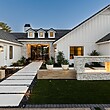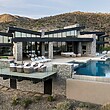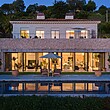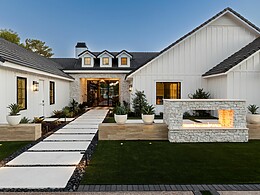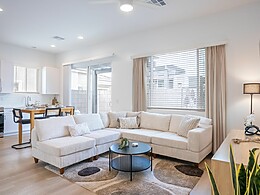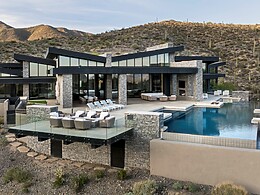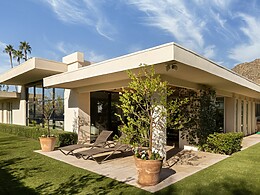Off-grid Earthship architectural community showcases reuse and radical self-reliance in Taos, New Mexico.

Baseball and rock ‘n’ roll have their own fantasy camps. So does off-grid, self-sustaining home construction, for four weeks at a time, in the wide open, high desert north of Taos, New Mexico.
Architect Michael Reynolds has been experimenting with recycled goods as building blocks since the early 1970s, designing and refining a style of hand-built home he calls an Earthship. In its simplest form, the Earthship sufficiently satisfies six basic human needs: shelter, water, food production, electricity, garbage management and human waste treatment.
Car and truck tires past their street prime are stacked and packed with dirt to form thermal-mass, load-bearing walls. Emptied aluminum cans and glass bottles fill space in non-load-bearing walls to reduce the use of energy-intensive Portland cement and create visual interest.
The most common style of Earthship has its entire north side nestled into an earth berm, which can provide respite from climatic heat, and a south face lined by a prolific greenhouse, which can share ambient warmth. Rain and snow are collected from the sloped roof, mechanically filtered and stored in massive cisterns, and water is used at least four times throughout households before being sent to septic fields. Domestic electricity is generated by individual solar collectors and, in places, wind turbines.

In its creation, an Earthship asks a lot in physical labor and systems know-how. But in its lifetime, it can be an ultimate roommate, eliminating water and energy bills and providing fresh food and comfort regardless of season.
Reynolds’ Earthships are primarily found in the Greater World Earthship Community, a 640-acre legally zoned subdivision in unincorporated Tres Piedras between Taos and the Colorado border. About 90 structures have been constructed here by Earthship Biotecture contractors, supervised students and independent builders using Reynolds’ plans.
Earthship Academy is the aforementioned fantasy camp. Admittance to the program is by application and a $2,750 course fee. Lay people of any background are eligible to participate, as the same building techniques have been deployed in global disaster relief using local, untrained, all-hands-on-deck participants.
Lectures, demonstrations and focused labor sessions are dealt in daily doses. There are no designer batting gloves or artisan-woven guitar straps at this fantasy camp; students source their school supply lists at Home Depot before arrival.
Logical introductions to Earthship ideals, prior to or instead of “camp,” can come far easier: Self-paced tours through the annotated, interactive visitor center are on a drop-in basis, 9 a.m. to 3 p.m. daily, for $8. Guided walking tours to several operational Earthships are by-reservation, Friday through Sunday, for $20.
Overnight rentals provide a demonstrably luxurious day-in-the-life sample of the off-grid lifestyle. Interior temperatures are manually cooled by opening intra-berm vents or warmed by cracking greenhouse transoms. Guests can access just-picked produce (and just-hatched eggs, where yard chickens apply) and gaze at sagebrush mesas and starry skies.
A few years ago, Christian Drake Lund and his wife Katie bought a 1,500-square-foot Earthship in the Greater World Community. Following a 2015 fire in their home in Massachusetts, and then a Sawdust Festival-focused stint in expensive Laguna Beach, California, the cast-iron furnituremaker and physical therapist “discovered” Taos in a YouTube video and eventually overnighted in an Earthship.
“As a little kid I was always enamored with treehouses,” Christian says, and this artisan house spoke to him. It was for sale at $425,000, and he and Katie seriously considered purchasing it, but couldn’t find a bank that understood the potential of the investment. The couple relocated to Taos proper and bought a traditional adobe home.
But while walking their Welsh Terrier, Finn, in the Greater World Community in 2019, Christian spotted an Earthship under construction and inquired within.
The Lunds were able to land this more modest model, “the Toyota Camry of Earthships,” Christian says, for $335,000 and found funding this time. They already had a house — but this breed of self-sufficient home had become the dream.
Their “Encounter 3” model has two bedrooms, one bath a centerpiece kitchen/living space, four intra-berm cooling tubes and a greenhouse alive with date and banana trees and flowering bougainvillea, geraniums and lavender. A full-size washer borrows catchment water to launder clothes, then ushers the lightly used liquid to toilet-flushing duty.
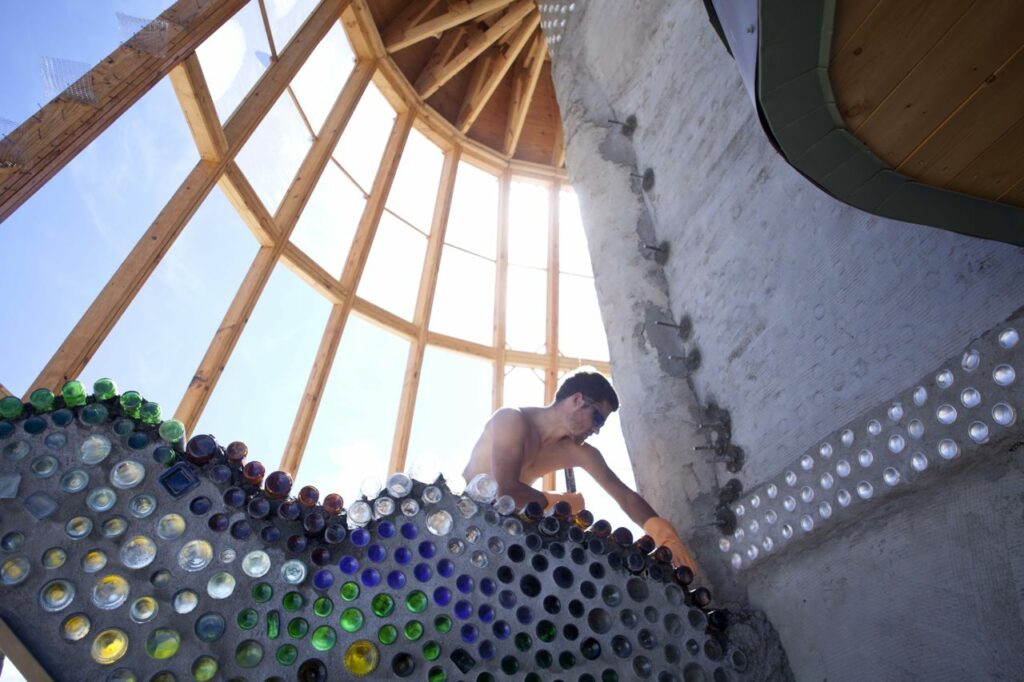
For now, almost in karmic gratitude, they offer their Earthship for overnight rentals on Airbnb so curious travelers can “kick the tires” of the off-grid lifestyle, and Earthship Academy students have the chance to rest inside the object of their curriculum.
“People are interested in reducing their carbon footprint, saving money and saving the planet,” Christian says, noting that an Earthship-enthusiast Instagram account he started, @taos_e3_earthship, instantly outpaced the one for his nine-year-old business.
And renegade Reynolds’ various house plans have been modified to provide comfortable grid independence far beyond the Land of Enchantment, in countries including Canada, Puerto Rico, Nicaragua, Haiti, South Africa and Scotland.
“Comfort adaptations made in Taos are based on our 7,000-foot elevation and high desert climate,” says Lauren Anderson, director of Earthship Academy.
“While climates in Arizona may be faced with a greater need for cooler interior regulation, the importance of double-pane greenhouses as a buffer zone, excellent insulation all around and additional cooling tubes may be a higher priority.”
She reports that Earthships have been erected in Wickenburg, Sedona, Cornville, Tucson and beyond.
For more information, go to earthshipbiotecture.com for building a home or overnight stays.
Sustainable Shopping
Don’t miss these three unique stores within 14 miles of the Earthship. With a thousand years of continuous inhabitation in structures formed from earthen material and fallen trees, Taos Pueblo is one of New Mexico’s original sustainable communities. Today, the American Indian community has about 150 full-time residents — yet in the 21st century, it remains steadfastly off the grid.
There, resident artists sell wares from their small studios while children and dogs play along the stream. 120 Veterans Hwy., taospueblo.com
Angelo McHorse, a registered member of Taos Pueblo, and his wife Jacquelene, formulate soaps, shampoos and balms using plants they’ve wild harvested or sourced from farmer friends. Sage-pine was their first natural blend in 2018 and is still the top seller.
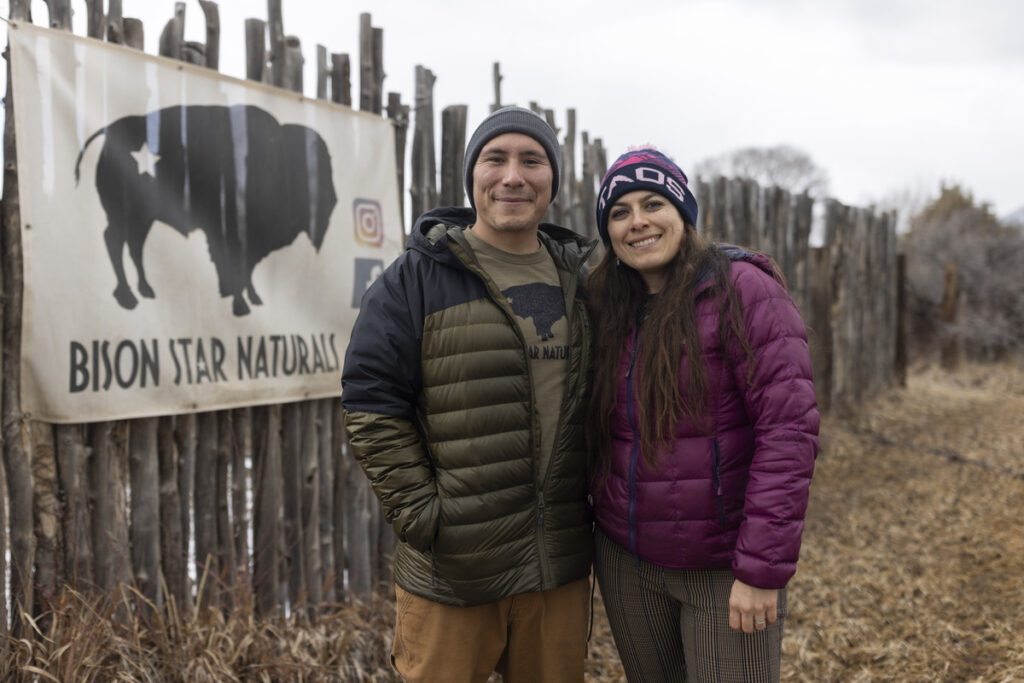
Their Bison Star Naturals brand is showcased in a friendly namesake boutique and select national park and museum gift shops. Due next from the hand-guided production line: bulk dispensers for hospitality partners, and a rich after-sun moisturizer. 1029 Paseo del Pueblo Norte, bisonstarnaturals.com
The ethic at Seconds Eco Store is innovative recycling. Artist/owner Sara Basehart taps handy workers from near and Fair Trade-far to populate her 13-year-old space among the John Dunn Shops with the likes of pop-top bags, automotive metal sculptures, compact disc jewelry, inner tube wallets and scrap paper basketry.
Know that you’re walking among Taos sustainability royalty here: Sara’s husband Phil was a longtime builder and instructor with Earthship Biotecture who now heads West Gorge Solar Construction, and the Basehart family has lived in the Greater World Earthship Community since 1993. 120 Bent St., secondsecostore.com
This story appeared in the AZ Foothills Home & Design, Best Places to Live issue. Read the full issue here.


